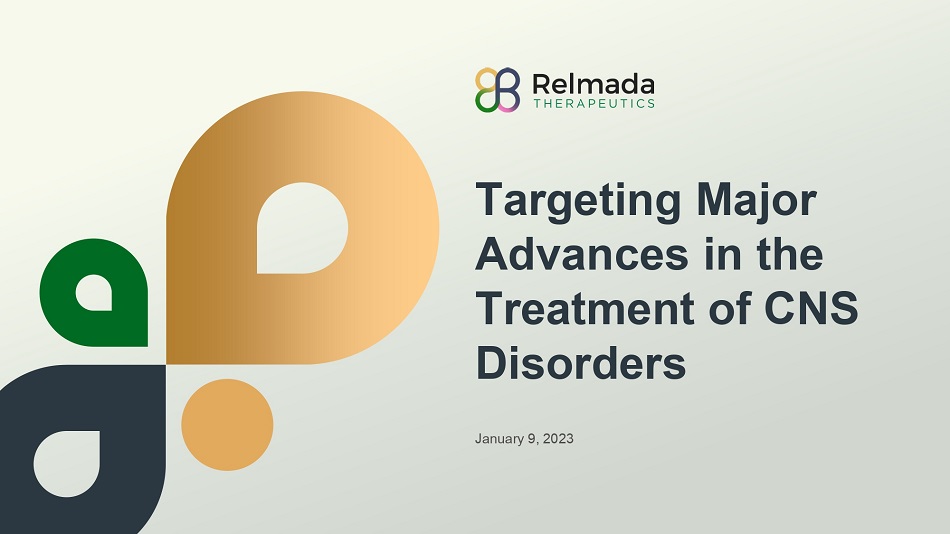
Exhibit 99.2

Targeting Major Advances in the Treatment of CNS Disorders January 9, 2023 EXHIBIT 99.2
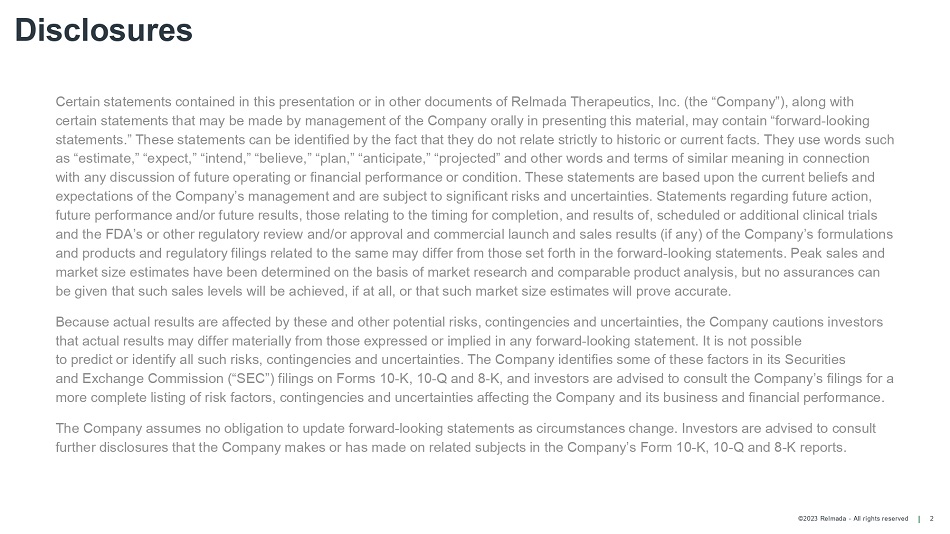
©2023 Relmada - All rights reserved Disclosures 2 Certain statements contained in this presentation or in other documents of Relmada Therapeutics, Inc. (the “Company”), along with certain statements that may be made by management of the Company orally in presenting this material, may contain “forward - looking statements.” These statements can be identified by the fact that they do not relate strictly to historic or current facts. They use words such as “estimate,” “expect,” “intend,” “believe,” “plan,” “anticipate,” “projected” and other words and terms of similar meaning in connection with any discussion of future operating or financial performance or condition. These statements are based upon the current beliefs and expectations of the Company’s management and are subject to significant risks and uncertainties. Statements regarding future action, future performance and/or future results, those relating to the timing for completion, and results of, scheduled or additional clinical trials and the FDA’s or other regulatory review and/or approval and commercial launch and sales results (if any) of the Company’s formulations and products and regulatory filings related to the same may differ from those set forth in the forward - looking statements. Peak sales and market size estimates have been determined on the basis of market research and comparable product analysis, but no assurances can be given that such sales levels will be achieved, if at all, or that such market size estimates will prove accurate. Because actual results are affected by these and other potential risks, contingencies and uncertainties, the Company cautions investors that actual results may differ materially from those expressed or implied in any forward - looking statement. It is not possible to predict or identify all such risks, contingencies and uncertainties. The Company identifies some of these factors in its Securities and Exchange Commission (“SEC”) filings on Forms 10 - K, 10 - Q and 8 - K, and investors are advised to consult the Company’s filings for a more complete listing of risk factors, contingencies and uncertainties affecting the Company and its business and financial performance. The Company assumes no obligation to update forward - looking statements as circumstances change. Investors are advised to consult further disclosures that the Company makes or has made on related subjects in the Company’s Form 10 - K, 10 - Q and 8 - K reports.
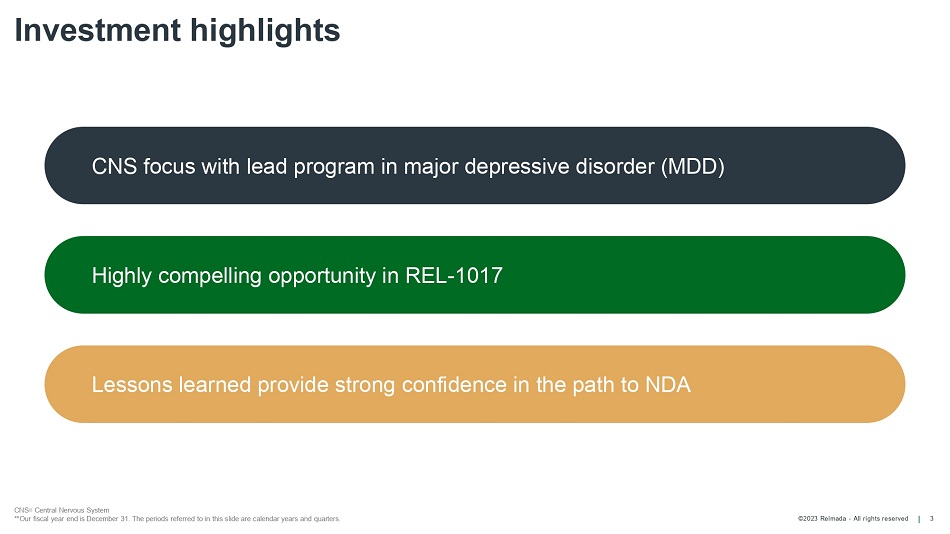
©2023 Relmada - All rights reserved Investment highlights 3 CNS focus with lead program in major depressive disorder (MDD) CNS= Central Nervous System **Our fiscal year end is December 31. The periods referred to in this slide are calendar years and quarters. Highly compelling opportunity in REL - 1017 Lessons learned provide strong confidence in the path to NDA
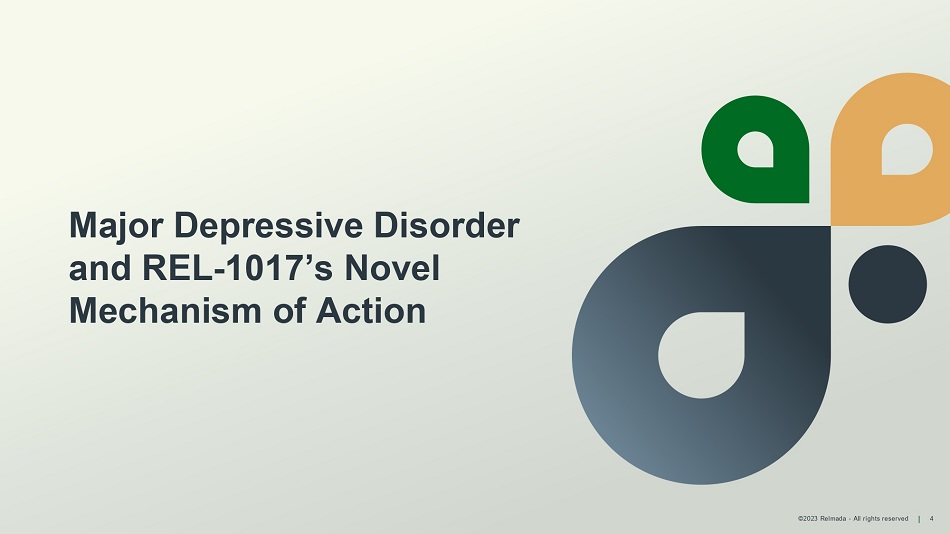
©2023 Relmada - All rights reserved 4 Major Depressive Disorder and REL - 1017’s Novel Mechanism of Action
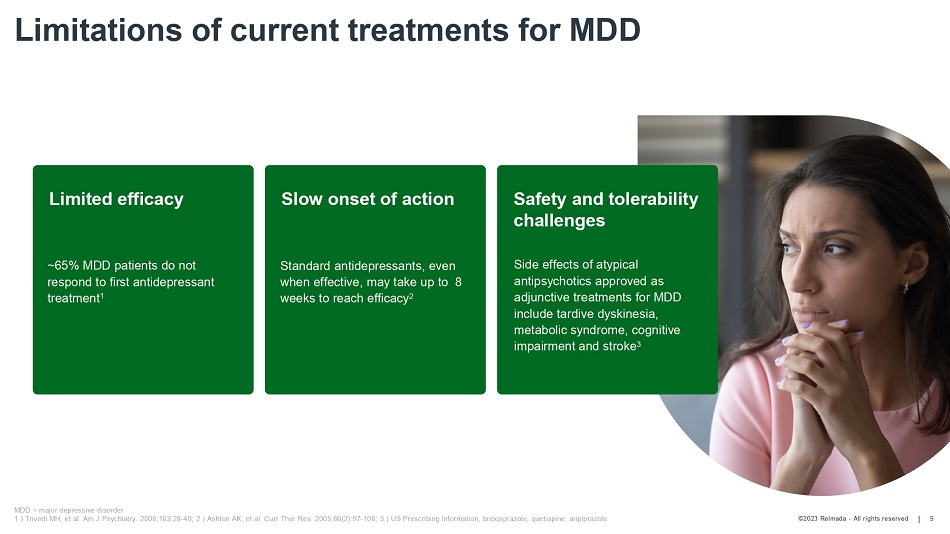
©2023 Relmada - All rights reserved Limitations of current treatments for MDD 5 MDD = major depressive disorder 1.) Trivedi MH, et al. Am J Psychiatry. 2006;163:28 - 40; 2.) Ashton AK, et al. Curr Ther Res. 2005;66(2):97 - 106; 3.) US Prescribing Information, brexpiprazole, quetiapine, aripiprazole Limited efficacy Slow onset of action Safety and tolerability challenges ~65% MDD patients do not respond to first antidepressant treatment 1 Side effects of atypical antipsychotics approved as adjunctive treatments for MDD include tardive dyskinesia, metabolic syndrome, cognitive impairment and stroke 3 Standard antidepressants, even when effective, may take up to 8 weeks to reach efficacy 2
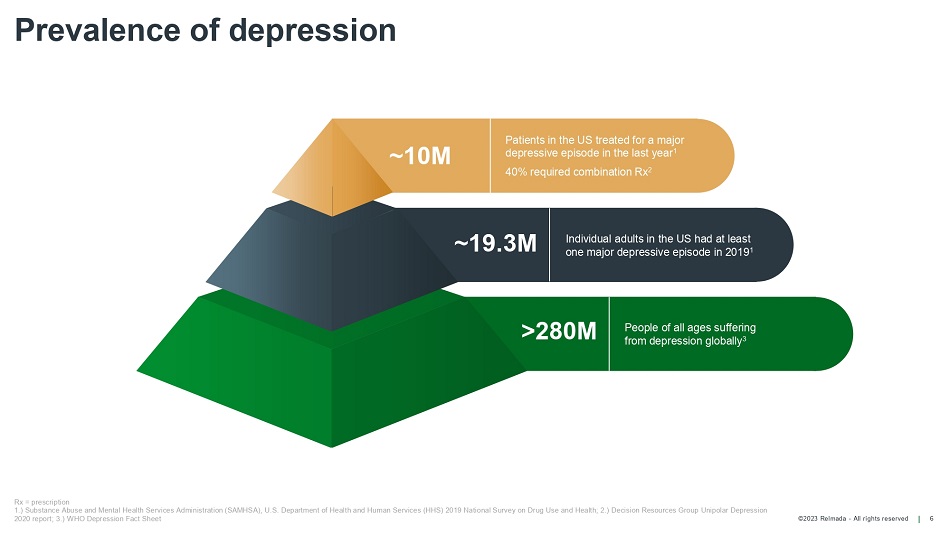
©2023 Relmada - All rights reserved Prevalence of depression 6 ~10M Patients in the US treated for a major depressive episode in the last year 1 40% required combination Rx 2 ~19.3M Individual adults in the US had at least one major depressive episode in 2019 1 >280M People of all ages suffering from depression globally 3 Rx = prescription 1.) Substance Abuse and Mental Health Services Administration (SAMHSA), U.S. Department of Health and Human Services (HHS) 2019 National Survey on Drug Use and Health; 2.) Decision Resources Group Unipolar Depression 2020 report; 3.) WHO Depression Fact Sheet
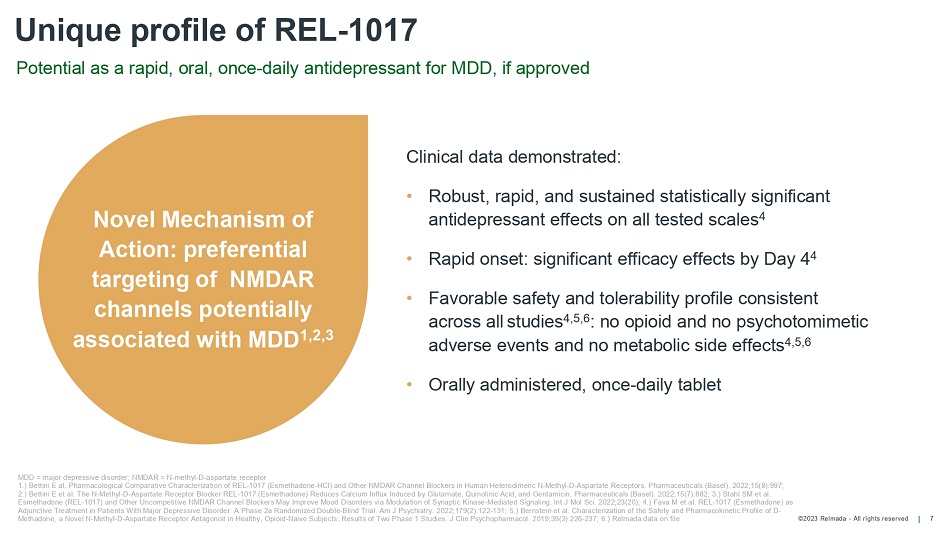
©2023 Relmada - All rights reserved Unique profile of REL - 1017 7 Potential as a rapid, oral, once - daily antidepressant for MDD, if approved MDD = major depressive disorder; NMDAR = N - methyl - D - aspartate receptor 1) Bettini E al. Pharmacological Comparative Characterization of REL - 1017 (Esmethadone - HCl) and Other NMDAR Channel Blockers in Human Heterodimeric N - Methyl - D - Aspartate Receptors. Pharmaceuticals (Basel). 2022;15(8):997; 2) Bettini E et al. The N - Methyl - D - Aspartate Receptor Blocker REL - 1017 (Esmethadone) Reduces Calcium Influx Induced by Glutamate, Quinolinic Acid, and Gentamicin. Pharmaceuticals (Basel). 2022;15(7):882; 3.) Stahl SM et al. Esmethadone (REL - 1017) and Other Uncompetitive NMDAR Channel Blockers May Improve Mood Disorders via Modulation of Synaptic Kinase - Mediated Signaling. Int J Mol Sci. 2022;23(20); 4.) Fava M et al. REL - 1017 (Esmethadone) as Adjunctive Treatment in Patients With Major Depressive Disorder: A Phase 2a Randomized Double - Blind Trial. Am J Psychiatry. 2022;179(2):122 - 131; 5.) Bernstein et al. Characterization of the Safety and Pharmacokinetic Profile of D - Methadone, a Novel N - Methyl - D - Aspartate Receptor Antagonist in Healthy, Opioid - Naive Subjects: Results of Two Phase 1 Studies. J Clin Psychopharmacol. 2019;39(3):226 - 237; 6.) Relmada data on file Clinical data demonstrated: • Robust, rapid, and sustained statistically significant antidepressant effects on all tested scales 4 • Rapid onset: significant efficacy effects by Day 4 4 • Favorable safety and tolerability profile consistent across all studies 4,5,6 : no opioid and no psychotomimetic adverse events and no metabolic side effects 4,5,6 • Orally administered, once - daily tablet Novel Mechanism of Action: preferential targeting of NMDAR channels potentially associated with MDD 1,2,3

©2023 Relmada - All rights reserved 8 REL - 1017 Phase 1 & 2 Efficacy and Safety Data
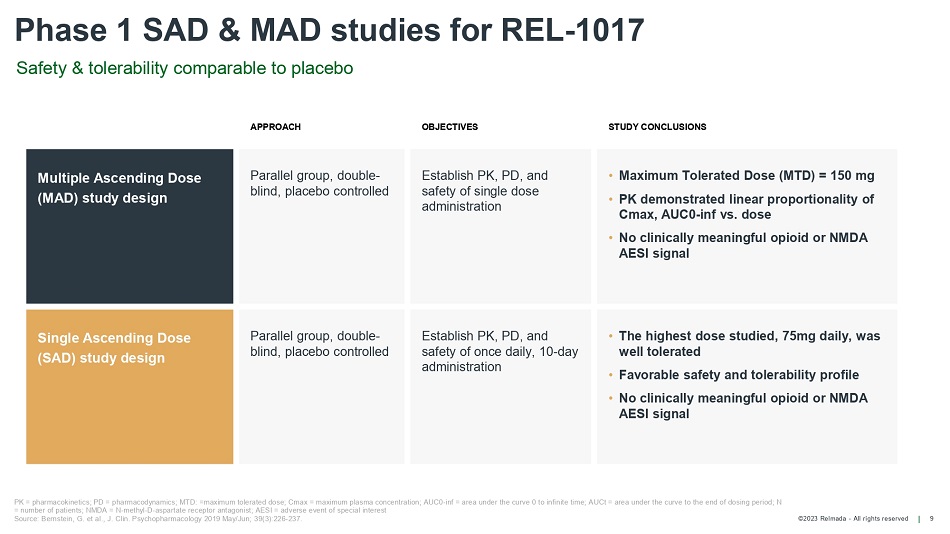
©2023 Relmada - All rights reserved Phase 1 SAD & MAD studies for REL - 1017 9 Safety & tolerability comparable to placebo APPROACH OBJECTIVES STUDY CONCLUSIONS Multiple Ascending Dose (MAD) study design Parallel group, double - blind, placebo controlled Establish PK, PD, and safety of single dose administration • Maximum Tolerated Dose (MTD) = 150 mg • PK demonstrated linear proportionality of Cmax, AUC0 - inf vs. dose • No clinically meaningful opioid or NMDA AESI signal Single Ascending Dose (SAD) study design Parallel group, double - blind, placebo controlled Establish PK, PD, and safety of once daily, 10 - day administration • The highest dose studied, 75mg daily, was well tolerated • Favorable safety and tolerability profile • No clinically meaningful opioid or NMDA AESI signal PK = pharmacokinetics; PD = pharmacodynamics; MTD: =maximum tolerated dose; Cmax = maximum plasma concentration; AUC0 - inf = area under the curve 0 to infinite time; AUCt = area under the curve to the end of dosing period; N = number of patients; NMDA = N - methyl - D - aspartate receptor antagonist; AESI = adverse event of special interest Source: Bernstein, G. et al., J. Clin. Psychopharmacology 2019 May/Jun; 39(3):226 - 237.
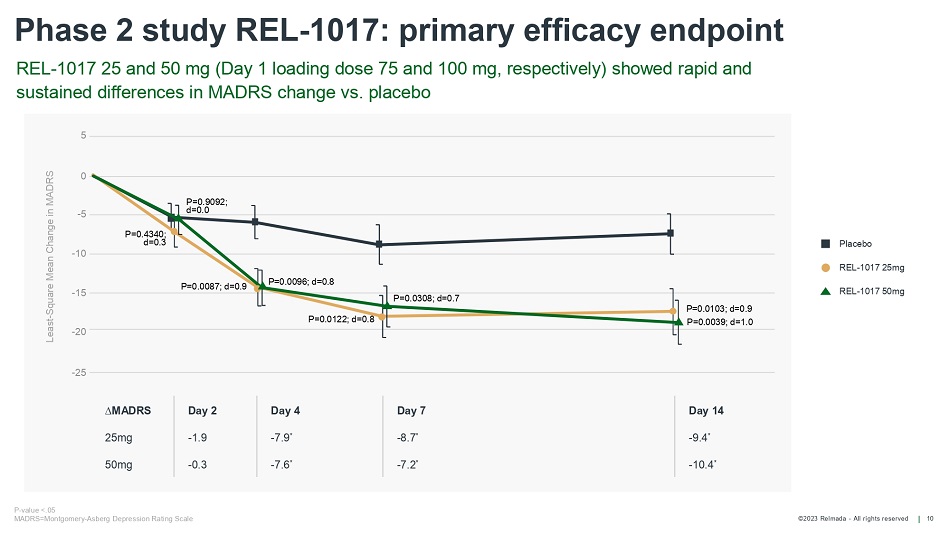
©2023 Relmada - All rights reserved Phase 2 study REL - 1017: primary efficacy endpoint REL - 1017 25 and 50 mg (Day 1 loading dose 75 and 100 mg, respectively) showed rapid and sustained differences in MADRS change vs. placebo 10 Least - Square Mean Change in MADRS 5 0 - 5 - 10 - 15 - 20 - 25 P=0.0103; d=0.9 P=0.0039; d=1.0 P=0.0308; d=0.7 P=0.0122; d=0.8 P=0.0096; d=0.8 P=0.0087; d=0.9 P=0.9092; d=0.0 P=0.4340; d=0.3 MADRS Day 2 Day 4 Day 7 Day 14 25mg - 1.9 - 7.9 * - 8.7 * - 9.4 * 50mg - 0.3 - 7.6 * - 7.2 * - 10.4 * Placebo REL - 1017 25mg REL - 1017 50mg P - value <.05 MADRS=Montgomery - Asberg Depression Rating Scale
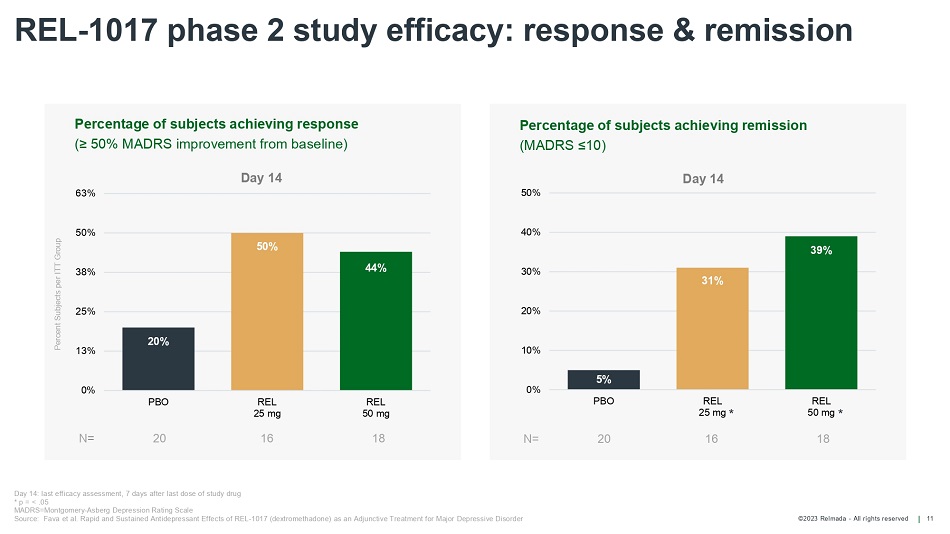
©2023 Relmada - All rights reserved REL - 1017 phase 2 study efficacy: response & remission 11 50% 44% 20% 0% 13% 25% 38% 50% 63% PBO REL 25 mg REL 50 mg Day 14 Percent Subjects per ITT Group Percentage of subjects achieving response (≥ 50% MADRS improvement from baseline) N = 20 16 18 31% 39% 0% 10% 20% 30% 40% 5% PBO Percentage of subjects achieving remission (MADRS ≤10) Day 14 50% N= 20 REL 25 mg * 16 REL 50 mg * 18 Day 14: last efficacy assessment, 7 days after last dose of study drug * p = < .05 MADRS=Montgomery - Asberg Depression Rating Scale Source: Fava et al. Rapid and Sustained Antidepressant Effects of REL - 1017 (dextromethadone) as an Adjunctive Treatment for Major Depressive Disorder
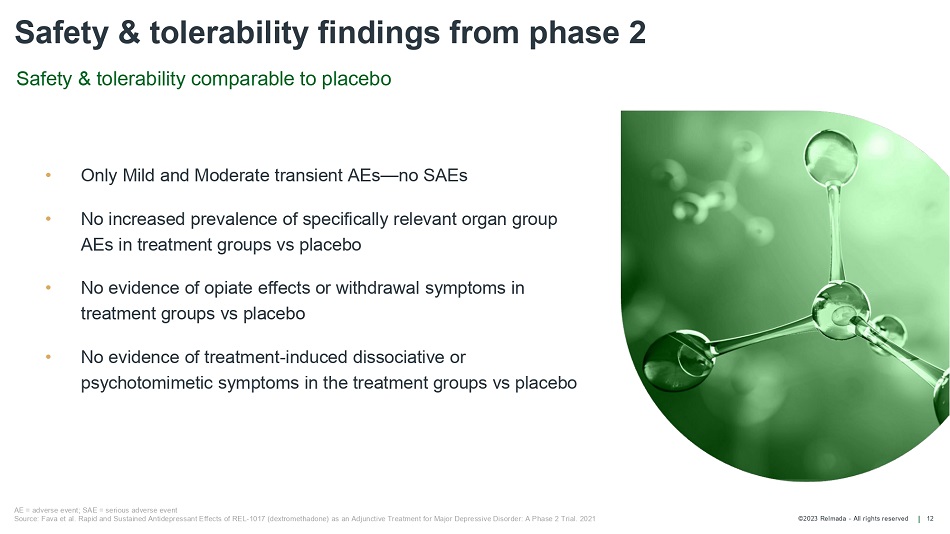
©2023 Relmada - All rights reserved Safety & tolerability findings from phase 2 12 • Only Mild and Moderate transient AEs — no SAEs • No increased prevalence of specifically relevant organ group AEs in treatment groups vs placebo • No evidence of opiate effects or withdrawal symptoms in treatment groups vs placebo • No evidence of treatment - induced dissociative or psychotomimetic symptoms in the treatment groups vs placebo Safety & tolerability comparable to placebo AE = adverse event; SAE = serious adverse event Source: Fava et al. Rapid and Sustained Antidepressant Effects of REL - 1017 (dextromethadone) as an Adjunctive Treatment for Major Depressive Disorder: A Phase 2 Trial. 2021
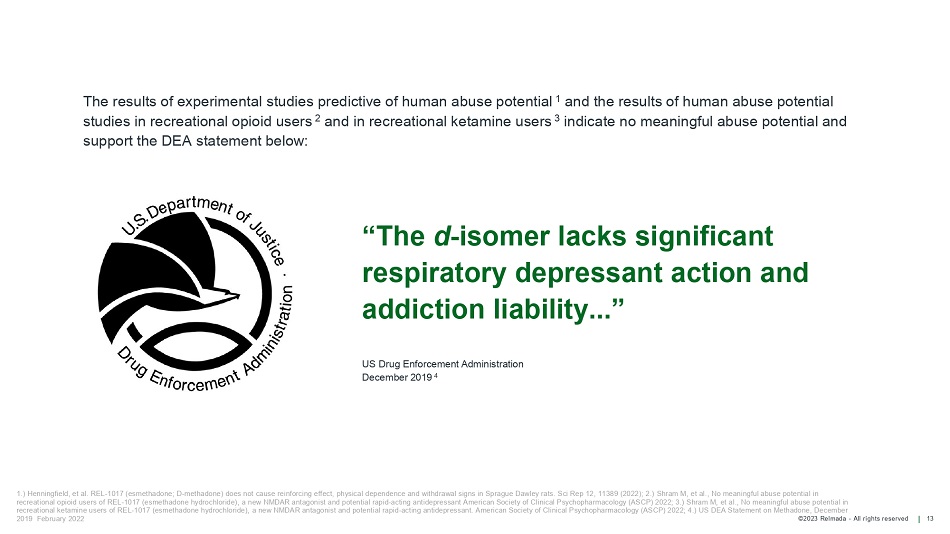
©2023 Relmada - All rights reserved 13 “The d - isomer lacks significant respiratory depressant action and addiction liability...” US Drug Enforcement Administration December 2019 4 1.) Henningfield, et al. REL - 1017 (esmethadone; D - methadone) does not cause reinforcing effect, physical dependence and withdrawal signs in Sprague Dawley rats. Sci Rep 12, 11389 (2022); 2.) Shram M, et al., No meaningful abuse potential in recreational opioid users of REL - 1017 (esmethadone hydrochloride), a new NMDAR antagonist and potential rapid - acting antidepressant American Society of Clinical Psychopharmacology (ASCP) 2022; 3.) Shram M, et al., No meaningful abuse potential in recreational ketamine users of REL - 1017 (esmethadone hydrochloride), a new NMDAR antagonist and potential rapid - acting antidepressant. American Society of Clinical Psychopharmacology (ASCP) 2022; 4.) US DEA Statement on Methadone, December 2019 February 2022 The results of experimental studies predictive of human abuse potential 1 and the results of human abuse potential studies in recreational opioid users 2 and in recreational ketamine users 3 indicate no meaningful abuse potential and support the DEA statement below:
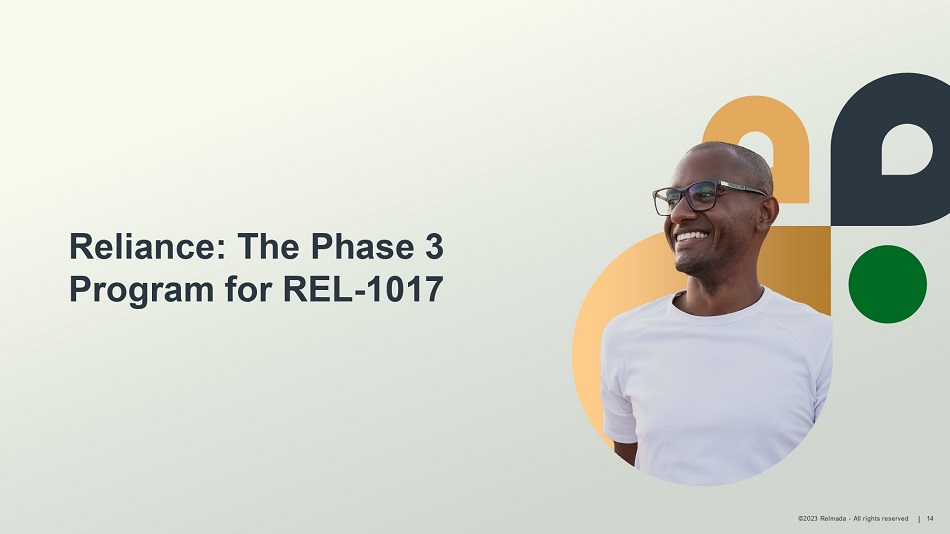
©2023 Relmada - All rights reserved 14 Reliance: The Phase 3 Program for REL - 1017
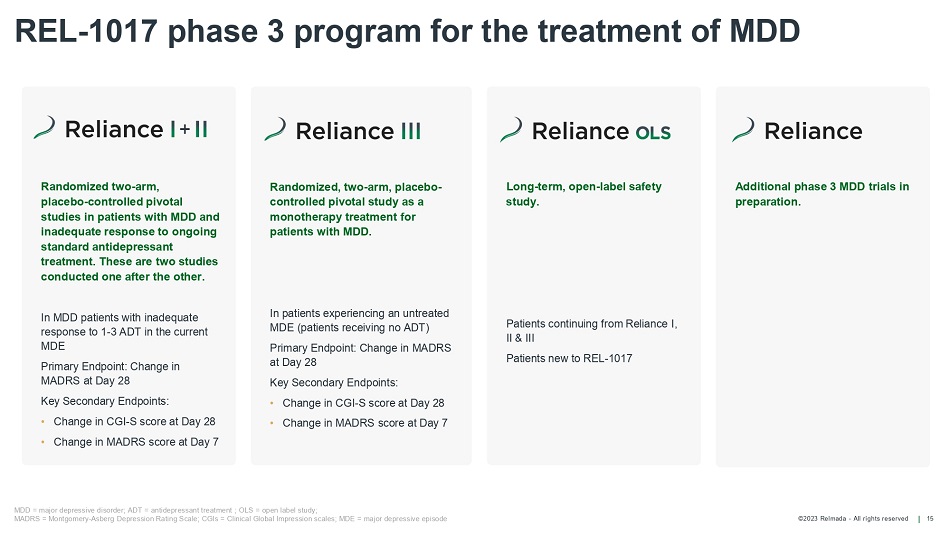
©2023 Relmada - All rights reserved Randomized, two - arm, placebo - controlled pivotal study as a monotherapy treatment for patients with MDD. In patients experiencing an untreated MDE (patients receiving no ADT) Primary Endpoint: Change in MADRS at Day 28 Key Secondary Endpoints: • Change in CGI - S score at Day 28 • Change in MADRS score at Day 7 Randomized two - arm, placebo - controlled pivotal studies in patients with MDD and inadequate response to ongoing standard antidepressant treatment. These are two studies conducted one after the other. In MDD patients with inadequate response to 1 - 3 ADT in the current MDE Primary Endpoint: Change in MADRS at Day 28 Key Secondary Endpoints: • Change in CGI - S score at Day 28 • Change in MADRS score at Day 7 Long - term, open - label safety study. Patients continuing from Reliance I, II & III Patients new to REL - 1017 REL - 1017 phase 3 program for the treatment of MDD 15 MDD = major depressive disorder; ADT = antidepressant treatment ; OLS = open label study; MADRS = Montgomery - Asberg Depression Rating Scale; CGIs = Clinical Global Impression scales; MDE = major depressive episode Additional phase 3 MDD trials in preparation. +

©2023 Relmada - All rights reserved Reliance I and Reliance III results overview 16 * Center - specific factors in these top - enrolling centers yielded paradoxical results: placebo robustly outperformed REL - 1017. The top enrolling center in Reliance III had a mean placebo response of 23 MADRS points Reliance I and Reliance III did not reach primary endpoint Reliance I showed a significant 40% response rate compared to placebo (p=0.044) Reliance I and Reliance III confirmed very favorable safety and lack of abuse potential In Reliance I and Reliance III, post - hoc analyses excluding 2 - 4 common top - enrolling centers* show a positive efficacy signal
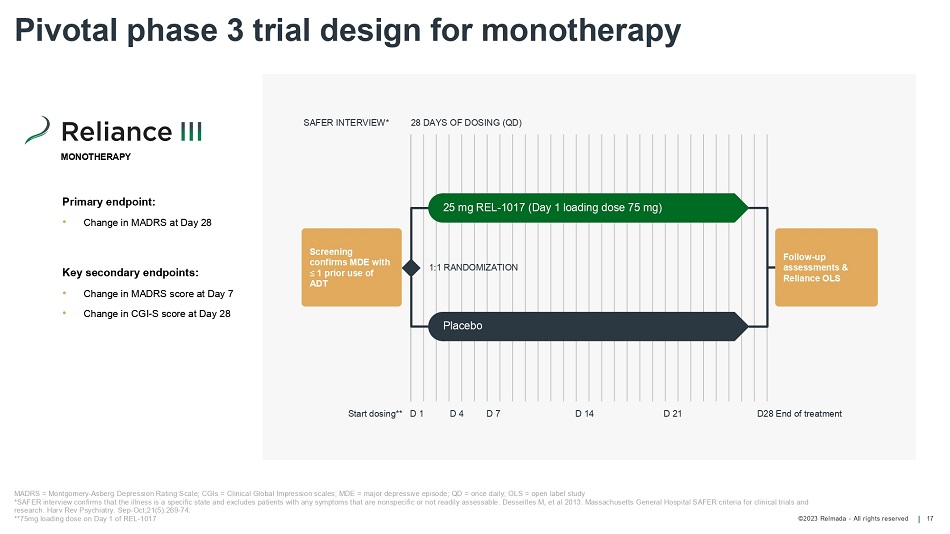
©2023 Relmada - All rights reserved Pivotal phase 3 trial design for monotherapy 17 Follow - up assessments & Reliance OLS 1:1 RANDOMIZATION 28 DAYS OF DOSING (QD) Start dosing** D 1 D 4 D 7 D 14 D28 End of treatment D 21 25 mg REL - 1017 (Day 1 loading dose 75 mg) Placebo SAFER INTERVIEW* Screening confirms MDE with ≤ 1 prior use of ADT MADRS = Montgomery - Asberg Depression Rating Scale; CGIs = Clinical Global Impression scales; MDE = major depressive episode; QD = once daily; OLS = open label study *SAFER interview confirms that the illness is a specific state and excludes patients with any symptoms that are nonspecific or not readily assessable. Desseilles M, et al 2013. Massachusetts General Hospital SAFER criteria for clinical trials and research. Harv Rev Psychiatry. Sep - Oct;21(5):269 - 74. **75mg loading dose on Day 1 of REL - 1017 Primary endpoint: • Change in MADRS at Day 28 Key secondary endpoints: • Change in MADRS score at Day 7 • Change in CGI - S score at Day 28 MONOTHERAPY
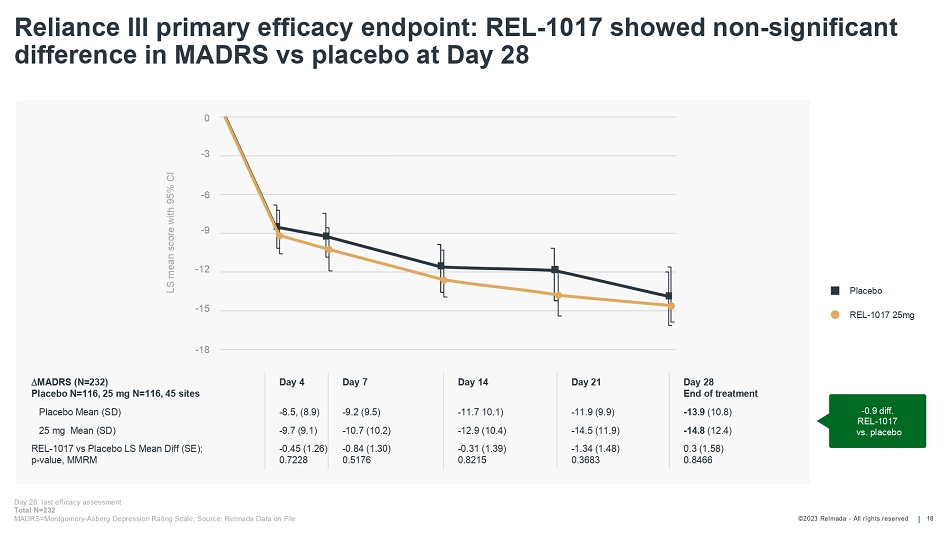
©2023 Relmada - All rights reserved Reliance III primary efficacy endpoint: REL - 1017 showed non - significant difference in MADRS vs placebo at Day 28 18 MADRS (N=232) Placebo N=116, 25 mg N=116, 45 sites Day 4 Day 7 Day 14 Day 21 Day 28 End of treatment Placebo Mean (SD) - 8.5, (8.9) - 9.2 (9.5) - 11.7 10.1) - 11.9 (9.9) - 13.9 (10.8) 25 mg Mean (SD) - 9.7 (9.1) - 10.7 (10.2) - 12.9 (10.4) - 14.5 (11.9) - 14.8 (12.4) REL - 1017 vs Placebo LS Mean Diff (SE); p - value, MMRM - 0.45 (1.26) 0.7228 - 0.84 (1.30) 0.5176 - 0.31 (1.39) 0.8215 - 1.34 (1.48) 0.3683 0.3 (1.58) 0.8466 - 0.9 diff. REL - 1017 vs. placebo Day 28: last efficacy assessment Total N=232 MADRS=Montgomery - Asberg Depression Rating Scale; Source: Relmada Data on File LS mean score with 95% CI - 15 0 - 3 - 6 - 9 - 12 - 18 Placebo REL - 1017 25mg

©2023 Relmada - All rights reserved Percent Subjects per ITT Group In Reliance III 39% of subjects achieved response and 22% achieved remission with 25 mg REL - 1017 in the full analysis set 19 N= 35% 39% 0% 10% 20% 30% 40% Percentage of subjects achieving response (≥ 50% MADRS improvement from baseline) Day 28 50% PBO REL 25 mg 45 16% 22% 0% 10% 20% 30% 40% Percentage of subjects achieving remission (MADRS ≤10) Day 28 50% PBO 19 REL 25 mg 25 N= 40 Day 28: last efficacy assessment Total N=232 MADRS=Montgomery - Asberg Depression Rating Scale; Source: Relmada Data on File
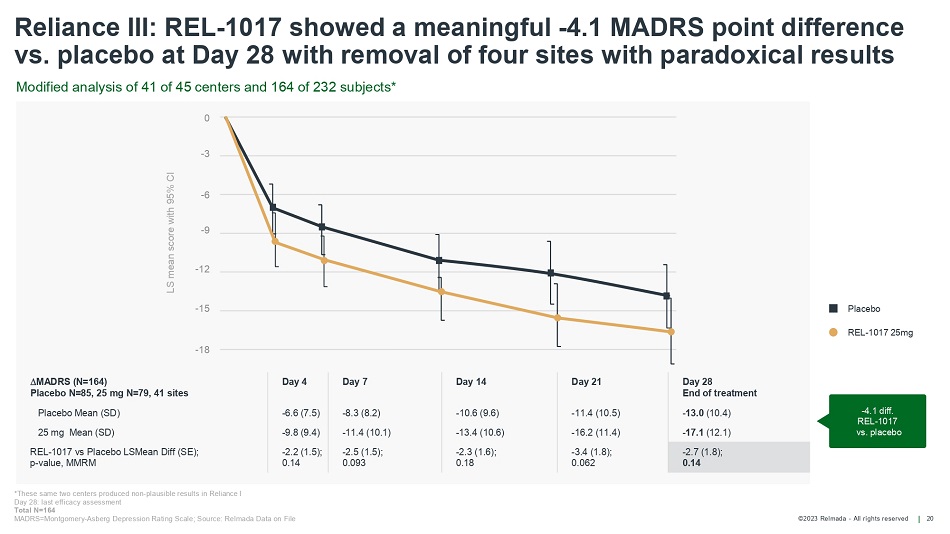
©2023 Relmada - All rights reserved Reliance III: REL - 1017 showed a meaningful - 4.1 MADRS point difference vs. placebo at Day 28 with removal of four sites with paradoxical results 20 *These same two centers produced non - plausible results in Reliance I Day 28: last efficacy assessment Total N=164 MADRS=Montgomery - Asberg Depression Rating Scale; Source: Relmada Data on File - 4.1 diff. REL - 1017 vs. placebo MADRS (N=164) Placebo N=85, 25 mg N=79, 41 sites Day 4 Day 7 Day 14 Day 21 Day 28 End of treatment Placebo Mean (SD) - 6.6 (7.5) - 8.3 (8.2) - 10.6 (9.6) - 11.4 (10.5) - 13.0 (10.4) 25 mg Mean (SD) - 9.8 (9.4) - 11.4 (10.1) - 13.4 (10.6) - 16.2 (11.4) - 17.1 (12.1) REL - 1017 vs Placebo LSMean Diff (SE); p - value, MMRM - 2.2 (1.5); 0.14 - 2.5 (1.5); 0.093 - 2.3 (1.6); 0.18 - 3.4 (1.8); 0.062 - 2.7 (1.8); 0.14 Placebo REL - 1017 25mg LS mean score with 95% CI - 15 Modified analysis of 41 of 45 centers and 164 of 232 subjects* 0 - 3 - 6 - 9 - 12 - 18
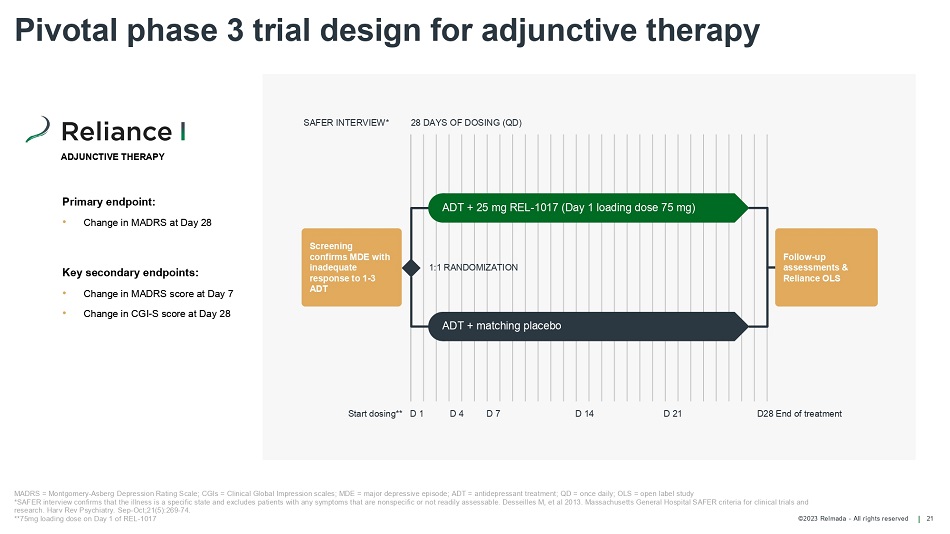
©2023 Relmada - All rights reserved Pivotal phase 3 trial design for adjunctive therapy 21 Primary endpoint: • Change in MADRS at Day 28 Key secondary endpoints: • Change in MADRS score at Day 7 • Change in CGI - S score at Day 28 Follow - up assessments & Reliance OLS 1:1 RANDOMIZATION 28 DAYS OF DOSING (QD) D28 End of treatment ADT + 25 mg REL - 1017 (Day 1 loading dose 75 mg) ADT + matching placebo SAFER INTERVIEW* Screening confirms MDE with inadequate response to 1 - 3 ADT MADRS = Montgomery - Asberg Depression Rating Scale; CGIs = Clinical Global Impression scales; MDE = major depressive episode; ADT = antidepressant treatment; QD = once daily; OLS = open label study *SAFER interview confirms that the illness is a specific state and excludes patients with any symptoms that are nonspecific or not readily assessable. Desseilles M, et al 2013. Massachusetts General Hospital SAFER criteria for clinical trials and research. Harv Rev Psychiatry. Sep - Oct;21(5):269 - 74. **75mg loading dose on Day 1 of REL - 1017 ADJUNCTIVE THERAPY Start dosing** D 1 D 4 D 7 D 14 D 21
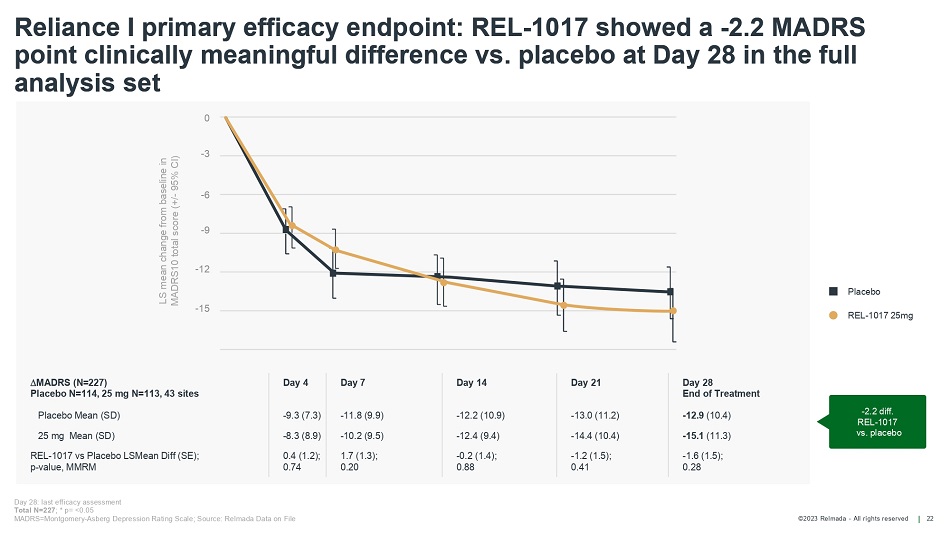
©2023 Relmada - All rights reserved 22 Day 28: last efficacy assessment Total N=227 ; * p= <0.05 MADRS=Montgomery - Asberg Depression Rating Scale; Source: Relmada Data on File MADRS (N=227) Placebo N=114, 25 mg N=113, 43 sites Day 4 Day 7 Day 14 Day 21 Day 28 End of Treatment Placebo Mean (SD) - 9.3 (7.3) - 11.8 (9.9) - 12.2 (10.9) - 13.0 (11.2) - 12.9 (10.4) 25 mg Mean (SD) - 8.3 (8.9) - 10.2 (9.5) - 12.4 (9.4) - 14.4 (10.4) - 15.1 (11.3) REL - 1017 vs Placebo LSMean Diff (SE); p - value, MMRM 0.4 (1.2); 0.74 1.7 (1.3); 0.20 - 0.2 (1.4); 0.88 - 1.2 (1.5); 0.41 - 1.6 (1.5); 0.28 - 2.2 diff. REL - 1017 vs. placebo Reliance I primary efficacy endpoint: REL - 1017 showed a - 2.2 MADRS point clinically meaningful difference vs. placebo at Day 28 in the full analysis set - 15 0 - 3 - 6 - 9 - 12 LS mean change from baseline in MADRS10 total score (+/ - 95% CI) Placebo REL - 1017 25mg
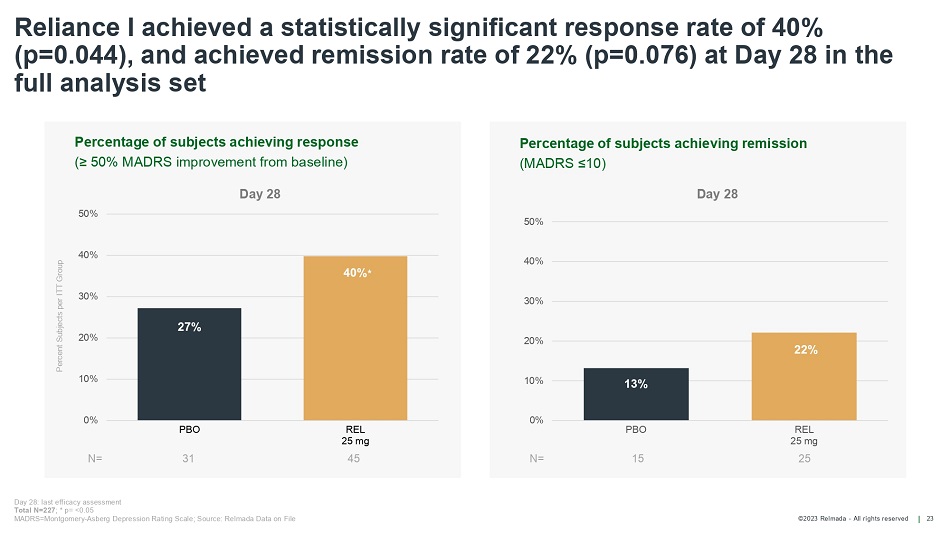
©2023 Relmada - All rights reserved Percentage of subjects achieving response (≥ 50% MADRS improvement from baseline) Reliance I achieved a statistically significant response rate of 40% (p=0.044), and achieved remission rate of 22% (p=0.076) at Day 28 in the full analysis set 23 N= 0% 10% 20% 30% 40% 50% PBO REL 25 mg 45 13% 22% 0% 10% 20% 30% 40% PBO 15 REL 25 mg 25 N= Percentage of subjects achieving remission (MADRS ≤10) Day 28 50% 31 40% * 27% Day 28: last efficacy assessment Total N=227 ; * p= <0.05 MADRS=Montgomery - Asberg Depression Rating Scale; Source: Relmada Data on File Percent Subjects per ITT Group Day 28
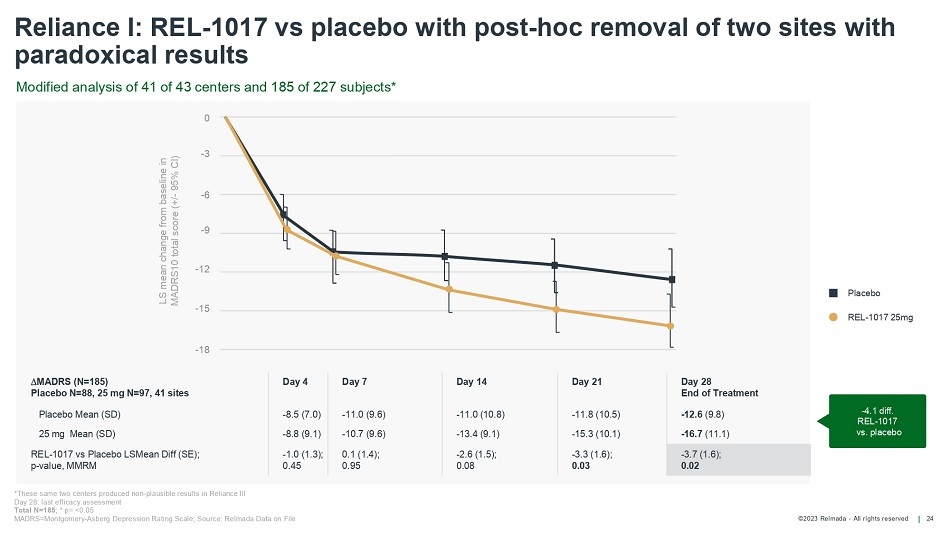
©2023 Relmada - All rights reserved 24 Reliance I: REL - 1017 vs placebo with post - hoc removal of two sites with paradoxical results - 4.1 diff. REL - 1017 vs. placebo MADRS (N=185) Placebo N=88, 25 mg N=97, 41 sites Day 4 Day 7 Day 14 Day 21 Day 28 End of Treatment Placebo Mean (SD) - 8.5 (7.0) - 11.0 (9.6) - 11.0 (10.8) - 11.8 (10.5) - 12.6 (9.8) 25 mg Mean (SD) - 8.8 (9.1) - 10.7 (9.6) - 13.4 (9.1) - 15.3 (10.1) - 16.7 (11.1) REL - 1017 vs Placebo LSMean Diff (SE); p - value, MMRM - 1.0 (1.3); 0.45 0.1 (1.4); 0.95 - 2.6 (1.5); 0.08 - 3.3 (1.6); 0.03 - 3.7 (1.6); 0.02 *These same two centers produced non - plausible results in Reliance III Day 28: last efficacy assessment Total N=185 ; * p= <0.05 MADRS=Montgomery - Asberg Depression Rating Scale; Source: Relmada Data on File Placebo REL - 1017 25mg LS mean change from baseline in MADRS10 total score (+/ - 95% CI) - 15 Modified analysis of 41 of 43 centers and 185 of 227 subjects* 0 - 3 - 6 - 9 - 12 - 18
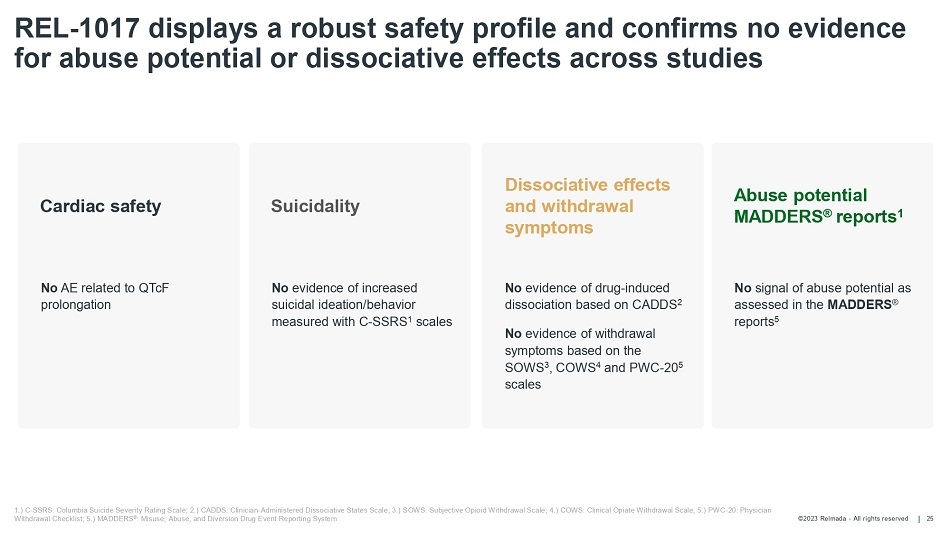
©2023 Relmada - All rights reserved REL - 1017 displays a robust safety profile and confirms no evidence for abuse potential or dissociative effects across studies 25 1.) C - SSRS: Columbia Suicide Severity Rating Scale; 2.) CADDS: Clinician - Administered Dissociative States Scale; 3.) SOWS: Subjective Opioid Withdrawal Scale; 4.) COWS: Clinical Opiate Withdrawal Scale; 5.) PWC - 20: Physician Withdrawal Checklist; 5.) MADDERS ® : Misuse, Abuse, and Diversion Drug Event Reporting System No AE related to QTcF prolongation No evidence of increased suicidal ideation/behavior measured with C - SSRS 1 scales No evidence of drug - induced dissociation based on CADDS 2 No evidence of withdrawal symptoms based on the SOWS 3 , COWS 4 and PWC - 20 5 scales No signal of abuse potential as assessed in the MADDERS ® reports 5 Cardiac safety Suicidality Dissociative effects and withdrawal symptoms Abuse potential MADDERS ® reports 1
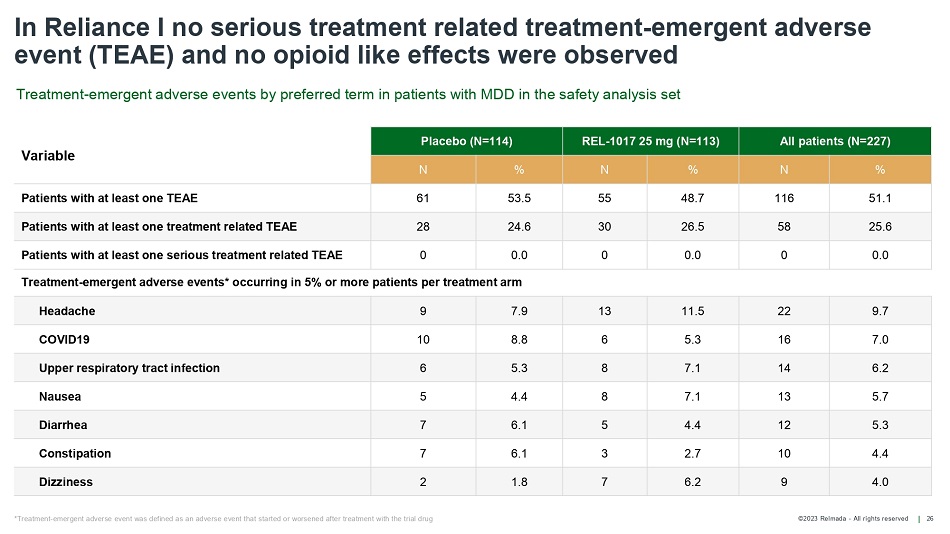
©2023 Relmada - All rights reserved In Reliance I no serious treatment related treatment - emergent adverse event (TEAE) and no opioid like effects were observed 26 Variable Placebo (N=114) REL - 1017 25 mg (N=113) All patients (N=227) N % N % N % Patients with at least one TEAE 61 53.5 55 48.7 116 51.1 Patients with at least one treatment related TEAE 28 24.6 30 26.5 58 25.6 Patients with at least one serious treatment related TEAE 0 0.0 0 0.0 0 0.0 Headache 9 7.9 13 11.5 22 9.7 COVID19 10 8.8 6 5.3 16 7.0 Upper respiratory tract infection 6 5.3 8 7.1 14 6.2 Nausea 5 4.4 8 7.1 13 5.7 Diarrhea 7 6.1 5 4.4 12 5.3 Constipation 7 6.1 3 2.7 10 4.4 Dizziness 2 1.8 7 6.2 9 4.0 Treatment - emergent adverse events* occurring in 5% or more patients per treatment arm Treatment - emergent adverse events by preferred term in patients with MDD in the safety analysis set *Treatment - emergent adverse event was defined as an adverse event that started or worsened after treatment with the trial drug

©2023 Relmada - All rights reserved In Reliance III no serious treatment related treatment - emergent adverse event (TEAE) and no opioid like effects were observed 27 *Treatment - emergent adverse event was defined as an adverse event that started or worsened after treatment with the trial drug Treatment - emergent adverse events by preferred term in patients with MDD in the safety analysis set Variable Placebo (N=116) REL - 1017 25 mg (N=116) All patients (N=232) N % N % N % Patients with at least one TEAE 56 48.3 62 53.4 118 50.9 Patients with at least one treatment related TEAE 37 31.9 39 33.6 76 32.8 Patients with at least one serious treatment related TEAE 0 0.0 0 0.0 0 0.0 Headache 11 9.5 13 11.2 24 10.3 Nausea 6 5.2 11 9.5 17 7.3 Dizziness 5 4.3 10 8.6 15 6.5 COVID19 3 2.6 11 9.5 14 6.0 Fatigue 4 3.4 6 5.2 10 4.3 Dry mouth 3 2.6 6 5.2 9 3.9 Treatment - emergent adverse events* occurring in 5% or more patients per treatment arm
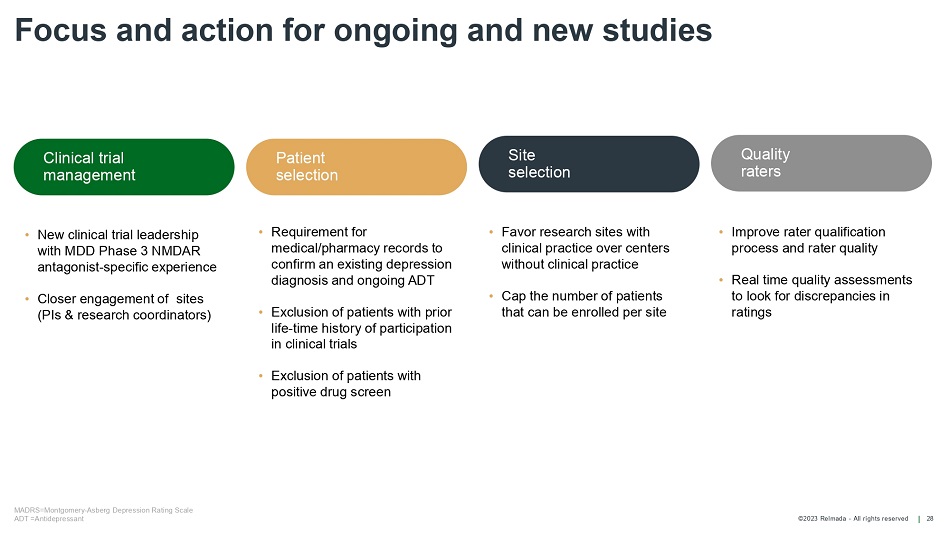
©2023 Relmada - All rights reserved Focus and action for ongoing and new studies 28 Clinical trial management MADRS=Montgomery - Asberg Depression Rating Scale ADT =Antidepressant Patient selection Site selection • Requirement for medical/pharmacy records to confirm an existing depression diagnosis and ongoing ADT • Exclusion of patients with prior life - time history of participation in clinical trials • Exclusion of patients with positive drug screen • New clinical trial leadership with MDD Phase 3 NMDAR antagonist - specific experience • Closer engagement of sites (PIs & research coordinators) • Favor research sites with clinical practice over centers without clinical practice • Cap the number of patients that can be enrolled per site Quality raters • Improve rater qualification process and rater quality • Real time quality assessments to look for discrepancies in ratings
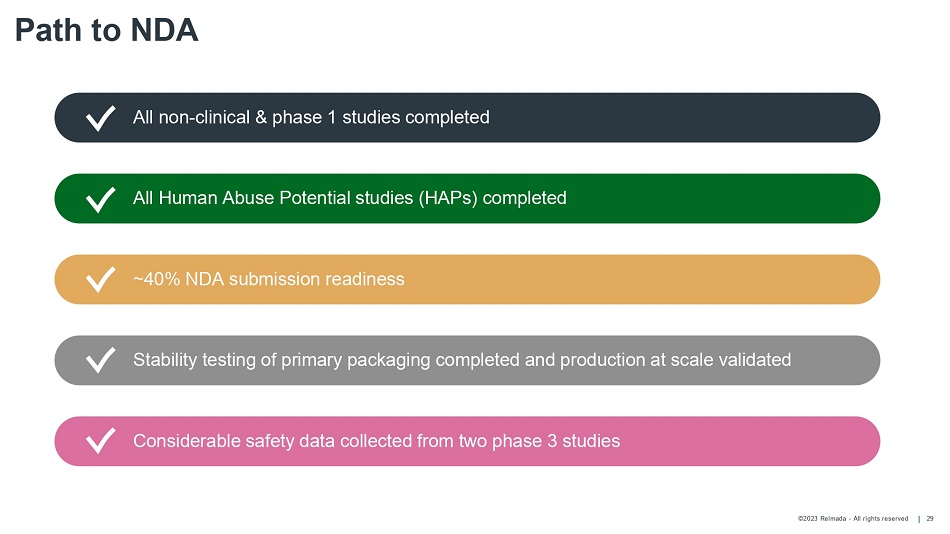
©2023 Relmada - All rights reserved Path to NDA 29 All non - clinical & phase 1 studies completed All Human Abuse Potential studies (HAPs) completed ~40% NDA submission readiness Stability testing of primary packaging completed and production at scale validated Considerable safety data collected from two phase 3 studies
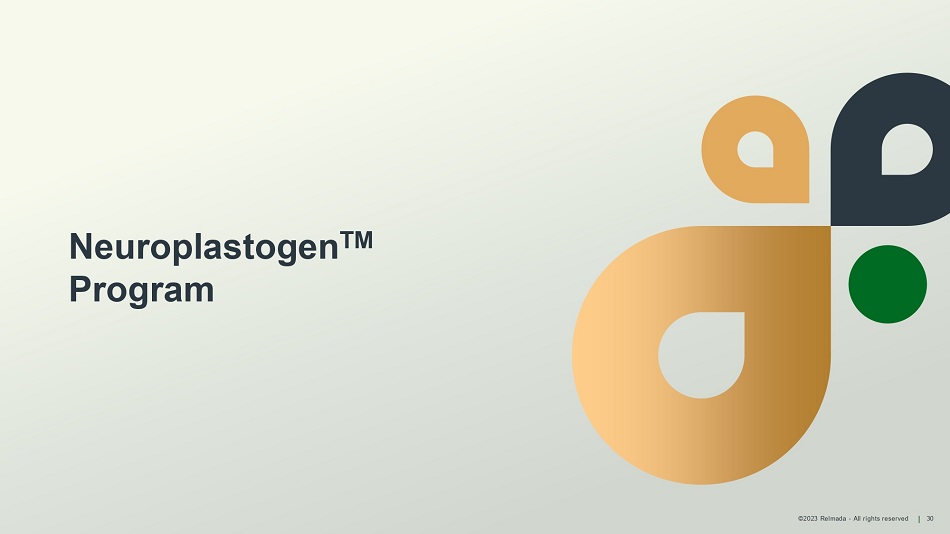
©2023 Relmada - All rights reserved 30 Neuroplastogen TM Program
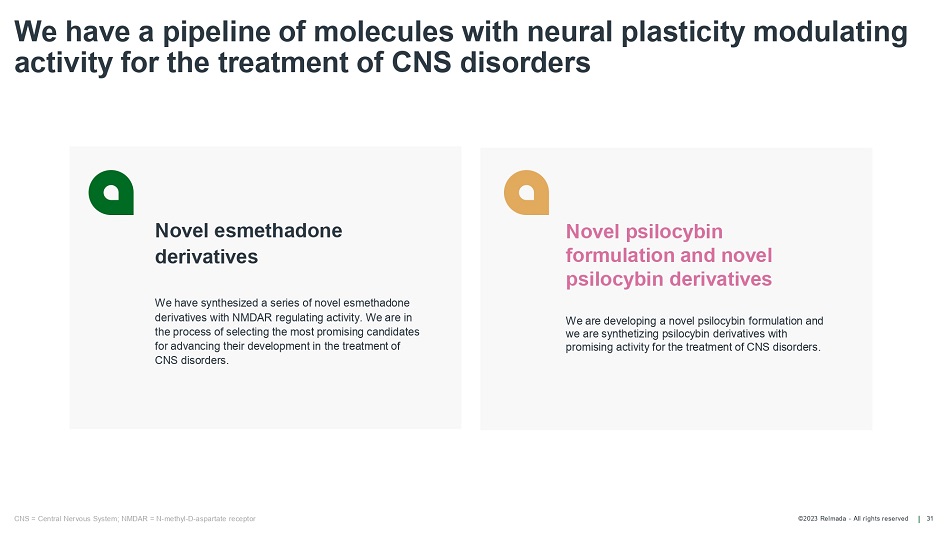
©2023 Relmada - All rights reserved We have a pipeline of molecules with neural plasticity modulating activity for the treatment of CNS disorders 31 Novel esmethadone derivatives We have synthesized a series of novel esmethadone derivatives with NMDAR regulating activity. We are in the process of selecting the most promising candidates for advancing their development in the treatment of CNS disorders. CNS = Central Nervous System; NMDAR = N - methyl - D - aspartate receptor Novel psilocybin formulation and novel psilocybin derivatives We are developing a novel psilocybin formulation and we are synthetizing psilocybin derivatives with promising activity for the treatment of CNS disorders.

©2023 Relmada - All rights reserved 32 Corporate Information
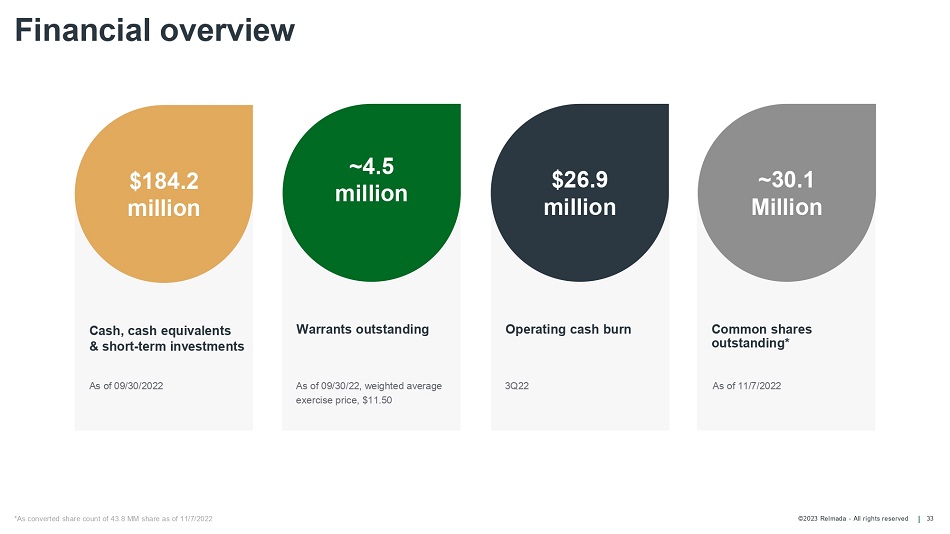
©2023 Relmada - All rights reserved Warrants outstanding Operating cash burn Common shares outstanding* Financial overview 33 Cash, cash equivalents & short - term investments $184.2 million ~4.5 million $26.9 million ~30.1 Million As of 09/30/22, weighted average exercise price, $11.50 3Q22 As of 11/7/2022 As of 09/30/2022 *As converted share count of 43.8 MM share as of 11/7/2022
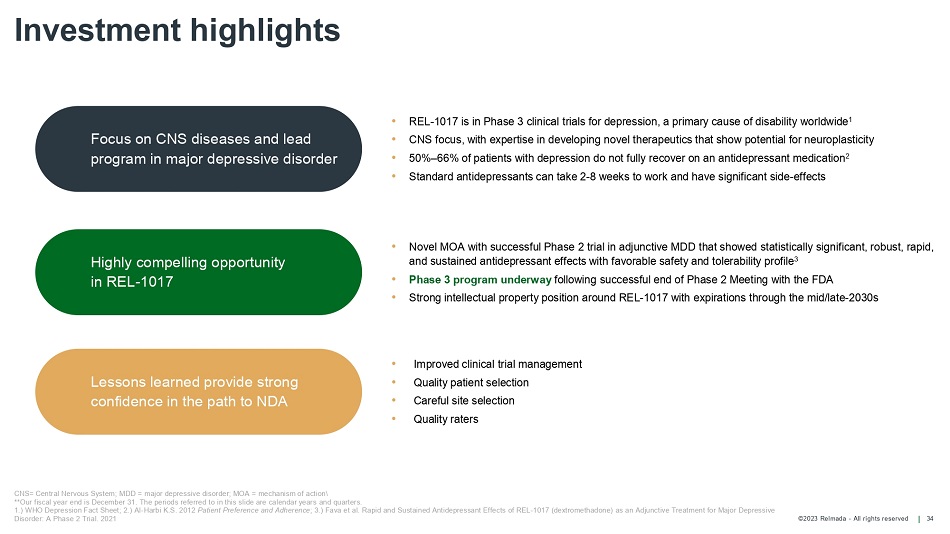
©2023 Relmada - All rights reserved Investment highlights 34 Focus on CNS diseases and lead program in major depressive disorder CNS= Central Nervous System; MDD = major depressive disorder; MOA = mechanism of action \ **Our fiscal year end is December 31. The periods referred to in this slide are calendar years and quarters. 1.) WHO Depression Fact Sheet; 2.) Al - Harbi K.S. 2012 Patient Preference and Adherence ; 3.) Fava et al. Rapid and Sustained Antidepressant Effects of REL - 1017 (dextromethadone) as an Adjunctive Treatment for Major Depressive Disorder: A Phase 2 Trial. 2021 Highly compelling opportunity in REL - 1017 Lessons learned provide strong confidence in the path to NDA • Novel MOA with successful Phase 2 trial in adjunctive MDD that showed statistically significant, robust, rapid, and sustained antidepressant effects with favorable safety and tolerability profile 3 • Phase 3 program underway following successful end of Phase 2 Meeting with the FDA • Strong intellectual property position around REL - 1017 with expirations through the mid/late - 2030s • REL - 1017 is in Phase 3 clinical trials for depression, a primary cause of disability worldwide 1 • CNS focus, with expertise in developing novel therapeutics that show potential for neuroplasticity • 50% – 66% of patients with depression do not fully recover on an antidepressant medication 2 • Standard antidepressants can take 2 - 8 weeks to work and have significant side - effects • Improved clinical trial management • Quality patient selection • Careful site selection • Quality raters
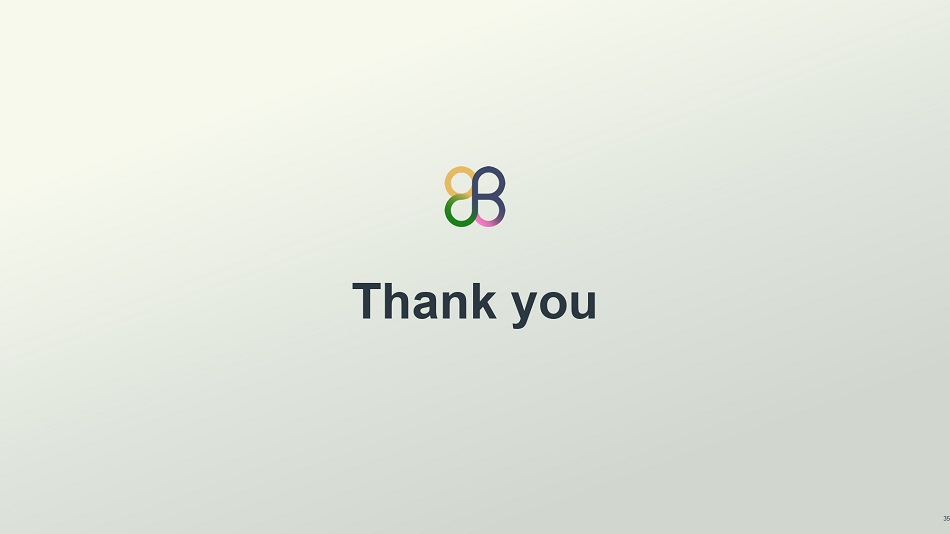
Thank you 35